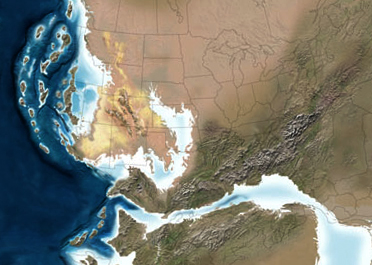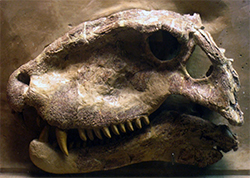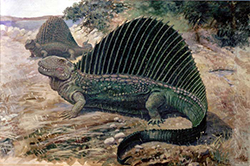The continental plate of Baltica slowly smashed into Laurentia, fusing into a suture that is still visible on interstate 40 at at mile marker 99, where a few footsteps can take you from the western sedimentary rocks of the Ordovician to the eastern pre-Cambium strata of ancient Asia.
 Continental USA during the Permian period 275 MYA Continental USA during the Permian period 275 MYA
Colliding continents absorbed the impact, and Iaptius Ocean that had once cradled sealife in the Paleozoic era was choked off by mountains forced and faulted skyward until they grew loftier than Everest -- massifs gradually incised by canyons that would soften and erode over hundreds of millions of years to become the hills of the Smoky Mountains and the mature west-bound river systems winding through today's Tennessee. After a massive ice age, the lush fern forests of Carboniferous receded as the equatorial supercontinent Pangaea dried out and became an inviting place for leafy, seed-bearing trees and land animals.
The first act of "Life on Planet Earth" was near its end. Extinction episodes had come and gone, but now in the final hours of the Paleozoic, a holocaust unprecedented in Earth's history would be unleashed -- an event that would come close to sterilizing our home world. The cause remains a mystery -- but the sun would soon set forever over the Permian's pleasant landscape of forest-carpeted lands -- and in the Mesozoic the sun would rise over a worldwide desert that was almost devoid of life.
|
|
 Dimetrodon grandis, U. of Michigan Dimetrodon grandis, U. of Michigan
As early Tennessee took shape, so did life on land. The primitive land-venturing amphibians had diversified into many new shapes and forms with skulls that could already be divided into two groups -- the reptile-like diapsids, and the mammal-like synapsids that included Dimetrodon.
 Dimetrodon, per Charles Knight Dimetrodon, per Charles Knight
Standing solidly on four legs, fin-backed Dimetrodon resembled a giant lizard, but this scaly animal was far different from the soft amphibians who laid their eggs in rivers, or the lizard-like reptiles that were becoming increasingly abundant. Neither mammal nor reptile but brother to both, this was a radically different kind of animal engineered for life on land. But the early success of the mammal-like synapsids would soon be cut short.

|